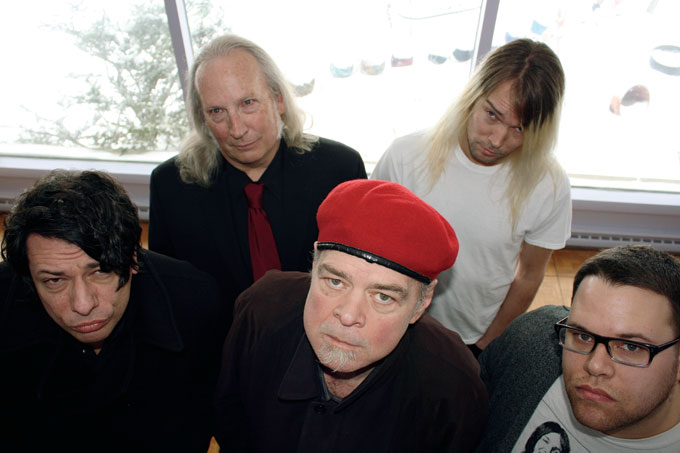Rocket From the Tombs
by Bill Nehill

One man drives while the other man screams
The world is awash with musicians who only received their due recognition posthumously. Artists as diverse as the Stooges, Big Star, Nick Drake, and the Velvet Underground all released wholly brilliant bodies of work that were mostly ignored during their existence only to have subsequently influenced generations of musicians and fans.
Amongst that ocean of seminal groups lies Cleveland’s Rocket From the Tombs, a group that never actually released a record during its short existence. Active for only a few short years on the dark side of the 1970s, Rocket From the Tombs were elemental in the evolution of both the initial punk and post-punk movements. And while they are also responsible for writing some of punk’s most primal classics such as “Sonic Reducer,” “Final Solution,” “30 Seconds Over Tokyo,” and “Ain’t It Fun,” Rocket From the Tombs remain relatively unknown to a wider audience.
In 1973, David Thomas (a.k.a. Crocus Behemoth) had been making his name in Cleveland as a local rock journalist. Wiry, intense, and highly intelligent, Thomas had dabbled in both art and film before trying his hand at performing music. While most of Cleveland’s music scene consisted of cover bands, Thomas was tapped into the art fuzz of bands such as the Velvet Underground, the Stooges, and the MC5, and intended to find others outside the mainstream.
After a stint in a Mothers of Invention-inspired band, Thomas formed Rocket From the Tombs. Named after a short film Thomas had made, Rocket From the Tombs began with mainly covers and a smattering of originals. However, with the addition of Peter Laughner as a writer and guitar player, the band was transformed. Laughner was a fellow rock journalist who worshiped at the altar of Lou Reed, and his recurring themes of isolation and alienation fed perfectly into Thomas’s nightmarish hallucinations of Cleveland’s desolate industrial landscapes.
Following Laughner’s entrance, Rocket From the Tombs added guitarist Gene O’Connor (a.k.a. Cheetah Chrome) and Johnny Madanski (a.k.a. Johnny Blitz) on drums. Both had been emulating the flamboyant decadence of Alice Cooper and New York Dolls. The final addition of bassist Craig Bell (of the likeminded Cleveland band Mirrors) completed the sound that Thomas had been envisioning since the early 1970s.
By mid 1974, the band had evolved into an intense maelstrom of sound: 4/4 garage rock collided with chaotic rhythms, non-linear noise blasts, and desperate living. And while performances were few, their shows were blurry and confrontational, with Thomas often resembling something close to a conflicted preacher. And while no one had actually seen or heard such music before, Rocket From the Tombs were able to attract a bit of a cult following. However, no record deal was forthcoming and amidst various lineup changes, including the brief appearance of future Dead Boys singer Stiv Bators, the band broke up acrimoniously in 1975. Little did they know that during their brief appearance that both their sound and many of their songs would become benchmarks in American underground music.
In the wake of Rockets From the Tombs breakup, Thomas and Laughner formed Pere Ubu, still one of the most unique and integral bands to ever come out of America. Pere Ubu transformed the Rockets vision into an even more frightening context. Still, Pere Ubu’s best known songs like “Final Solution,” “30 Seconds Over Tokyo,” and “Life Stinks” stem from their previous band.
On the other side, O’Connor, Madanski, and Bators moved to New York and formed the notorious Dead Boys. Leaving all the art and avant-garde behind, the Dead Boys’ initial success was also based on their past work, using “Ain’t It Fun” and the often covered “Sonic Reducer,” the latter much to the chagrin of Thomas.
Unfortunately, unlike many of their contemporaries, Rocket From the Tombs never recorded that album that could have brought a wider audience. A smattering of live shows and rehearsal tapes circulated throughout the years and, thanks to the high regard of both Pere Ubu and the Dead Boys, much has been written about them.
In 1998, Richie Unterberger’s book Unknown Legends of Rock And Roll gave them more exposure than they’d ever received during their existence. Not long after, Smog Veil Records issued The Day the Earth Met Rocket From the Tombs, a compilation of the aforementioned tapes, which piqued public interest even more. In response, Thomas reformed the band in 2003 with O’Connor and Bell, occasionally performing live shows and finally recording an album of their songs in a proper studio. While Thomas continues with Pere Ubu and his various other projects, he has sporadically continued with Rocket From the Tombs. A second album, Barfly, is all new material and was released last year.
Thomas once said that no band is ahead of its time, that they can either be behind time or of its time. If this is true, Rocket From the Tombs were one of few that were truly of their time. Few others were able to capture sonically the desperation and alienation of the early 1970s. It just took a long time for others to see what was going on.
Rocket From the Tombs performs at Mohawk Place on Saturday, October 6, with special guests Thee Electric Magi Chippie and High Flyin’ Babys. Doors open at 8pm.
blog comments powered by Disqus|
Issue Navigation> Issue Index > v11n40 (Week of Thursday, October 4) > Rocket From the Tombs This Week's Issue • Artvoice Daily • Artvoice TV • Events Calendar • Classifieds |









 Current Issue
Current Issue